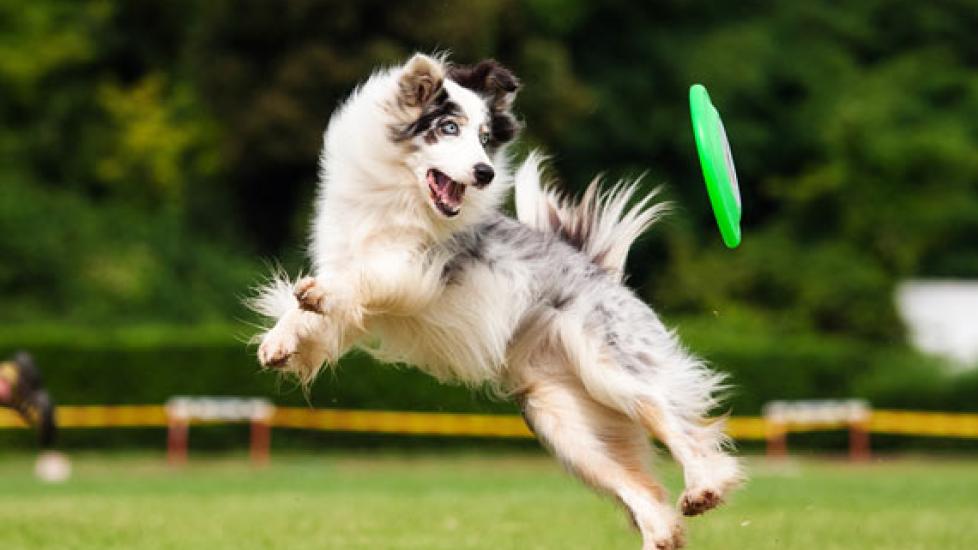Sport Nutrition Bars for Dogs
My graduate studies in human exercise physiology and sports nutrition confirmed that serious athletes will use any means to gain the slightest competitive edge. Short of blood doping like Lance Armstrong, there are legitimate nutritional techniques that can help athletes maintain a high level of performance.
It appears that human nutritional strategies can also help canine athletes gain a competitive edge. A study in the latest issue of the American Journal of Veterinary Research tested a sports bar for dogs that is similar to exercise recovery products for humans to see if it could help canine athletes. They found that this bar may help canine athletes recover faster and be ready for further competition.
The Use of Energy Sources in Sports
Athletic performance requires energy. Energy or calories can only be stored in the body as carbohydrates, fat, or protein. That’s it. Athletes try to maximize their body stores of these energy sources without adding unnecessary body weight that would decrease athletic performance.
Carbohydrates are stored in the form of glycogen in the muscles and liver. Muscle glycogen supplies sugar or glucose directly to the muscles during exercise. The liver glycogen is a “back-up” to deliver glucose as the muscles use up their glycogen. Unlike humans, dogs do not use large amounts of glycogen during exercise and therefore have very small stores of glycogen in their muscles and liver.
Proteins from muscle are also used for energy during exercise. This means that muscles are actually torn down during athletic events. Muscle protein is a major source of energy for dogs during exercise and athletic performance.
Fat provides the greatest amount of calories per unit of weight. But using fat for calories requires lots of oxygen. Humans can only use oxygen to burn fat at lower levels of exercise intensity. This means the faster or harder you exercise, the less fat you burn directly for energy. Human athletes can only burn large amounts of fat if they slow down to an intermediate level of exercise. Otherwise fat is burned after exercise while the body restores its glycogen and proteins.
Remarkably, dogs can burn fat at very high levels of exercise intensity. In fact, protein and fat are the major fuels for athletic performance in dogs. This is why sled dogs can pull for 10-12 hours without slowing, while a human could not perform at that intense level of exercise for that long.
Recommended Pet Products
- Nutramax Proviable Probiotics & Prebiotics Digestive Health Supplement for Dogs & Cats, 160 count$89.98Chewy Price
- Fera Pets USDA Organic Pumpkin Plus Fiber Support for Dogs & Cats, 90 servings$34.95Chewy Price
- All Four Paws Comfy Cone E-Collar for Dogs & Cats, Black, Small$20.24Chewy Price
- Virbac Epi-Otic Advanced Ear Cleaner for Dogs & Cats, 4-fl oz bottle$12.34Chewy Price
Nutritional Strategies for Sports
Post-Event Nutrition
Human studies show that the absorption of glucose by the gut and muscle is greater within 60 minutes after exercise. Further studies indicate that glucose eaten with protein after exercise promotes muscle production. This research has created a large number of products for human athletes that combine various sugars and amino acids for post-exercise recovery. This dog study examined a similar “recovery bar” that has become popular with owners of working dogs.
The canine sports bar contains maltodextrin and whey protein. Maltodextrin has the highest glycemic index of all sugars so it is readily absorbed from the gut. Whey, a protein by-product of cheese production, contains large amounts of branched-chain amino acids (BCAA) that are important for building muscle.
The researchers found that the sports bar readily increases blood levels for glucose and BCAA and sustains them at levels necessary to replenish glycogen and muscle tissue. Because glycogen stores are limited in dogs, unused glucose can be converted to fat to replace fat stores that were depleted during exercise.
Unfortunately, the researchers did not biopsy fat, muscles, or livers in these dogs to verify that the glucose and BCAA in the blood did in fact replenish glycogen, fat, and muscle tissue. Despite definitive proof, the study suggests that canine athletes can benefit from post-event nutritional strategies.
But don’t assume these sports bars are appropriate for your dog. They are very high in calories (250 calories/bar) and are intended for nutritional recovery for extreme canine athletes (i.e., sled dogs), intensively trained herding or event dogs, or rescue and military dogs subjected to prolonged, intense activity.
250 calories from maltodextrin and whey will not transform your dog into an athlete; it will only promote weight gain.

Dr. Ken Tudor
Image: Ksenia Raykova / Shutterstock




